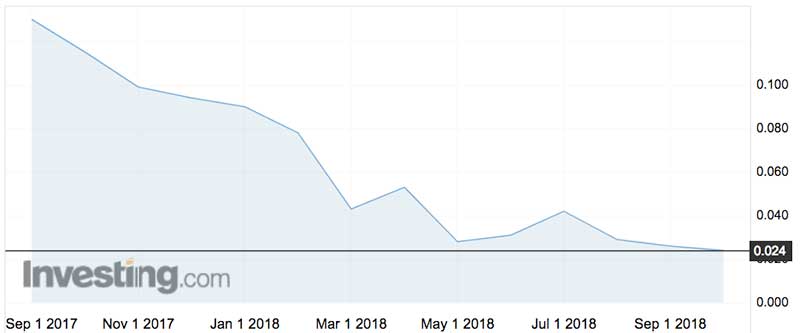This media business went into administration before its crowd-funding campaign ended

A Stockhead review of equity crowdfunding in Australia found the concept has yet to live up to the hype with at least seven businesses failing to reach their fund-raising targets.
Today journalist Rachel Williamson digs deeper into two cases
Baby boomer publisher WYZA launched one of the first equity crowd-funding campaigns on platforms such as OnMarket at the end of 2016.
WYZA — formerly known as RetirementLiving.TV — calls itself the leading online media platform for Australia’s over-50s audience”.
“We’re disrupting the $200 billion spending patterns of this powerful demographic and are capital raising for our next exciting phase of growth, using crowdfunding as an incredible new way of raising equity for both business and investors alike,” CEO Michael Farley said on LinkedIN in November 2016.
But before WYZA’s crowd-funding campaign hit its final deadline it had already gone into administration.
Wyza was due to close its campaign for a $200,000 to $500,000 crowdfunding campaign on June 15.
But the corporate administrator was called in on June 14 after they only hit $62,000.
Equity crowdfunding was never supposed to be the last resort of businesses desperate for a new lifeline of cash.
But Australia has seen several examples of the system being used for that purpose since it was launched in January.
Lost money
About 70 of WYZA’s pre-crowdfunding investors lost money, the administrator told Stockhead.
But there were red flags in the company’s own offer document.
“In the current financial year of 2017-18, pending the appointment of new directors and the injection of new private equity funds, the Board resolved at the start of this financial year to enter into a ‘low activity’ business operating model,” the document said.
“At the minimum subscription of $200,000, cash reserves will not be adequate for funding requirements.”
The company made $336,978 revenue in the 2017 fiscal year, yet planned to pay its CEO $252,000 a year and general manager $144,000 a year.
It had tried to crowdfund once before in New Zealand in 2016 — and failed then too.
OnMarket managing director Nick Motteram said Wyza needed money to fund growth — and “realised that if that money didn’t come in they weren’t solvent”.
“Ideally, a company coming for crowdfunding, this isn’t their last final fling at life,” he told Stockhead.
The case of CropLogic
What happens when a crowd-funded venture makes it to the stockmarket?
Just over a year ago agtech play Croplogic (ASX:CLI) became the first crowd-funded business to list on the ASX.
CropLogic — which makes technology to help farmers track data such as soil temperature and moisture — joined the ASX in September 2017 after raising $8 million at 20c.
The stock now trades at about 2.4c:

Its managing director later quit and the board is trying to rebuild with a new strategy.
Croplogic raised $NZ512,200 ($469,000) on the platform Equitise’s New Zealand arm in 2016, from a campaign looking for $NZ400,000 to $NZ1m.
A valuation by Edison in 2016 said the company would need another $12m “to fund losses until FY20” — more than the $8 million later raised in the IPO.
Equitise managing director Chris Gilbert dismisses the crowd-funding campaign as being from New Zealand, saying the rules there are not as tight as in Australia.
He also highlights its time as a Powerhouse Ventures (ASX:PVL) investment “which is probably equally not as good”. Powerhouse has presided over a series of bad investments.
“We’re a platform that does a level of diligence to put forward interesting investment opportunities for our investor base and we can’t do much more outside of that,” Mr Gilbert says. “We are a marketplace.”
“From our point of view we really care about reputational risk.
“In New Zealand we didn’t have a huge amount of decent deal flow so we went months without putting up an offer. We never put up an offer for a quick fee.”
The last resort
Earlier this year a study of crowd-funded business found they were “less profitable [and] more often have excessive debt levels”.
The study — published in the July edition of the Journal of Business Venturing — compared 277 companies that crowdfunded on the British “CrowdCube” platform with similar firms that sought funding elsewhere.
“In line with the pecking order theory, the empirical evidence shows that firms listed on equity crowdfunding platforms are less profitable, more often have excessive debt levels, and have more intangible assets than matched firms not listed on these platforms,” the study said.
“When internal funds are lacking, entrepreneurs will search for debt financing and choose only external equity financing, including equity crowdfunding, as a last resort.”
Do Your Own Homework
Due diligence carried out on companies undertaking equity crowdfunding is often mixed.
The OnMarket platform looks at a company’s financial position and they get to know the management.
Mr Motteram says they ask as many questions as possible, but if they withhold information “there’s not much we can do”.
At consumer brand platform Birchal, crowdfunding expert Alan Crabbe, lawyer Matt Vitale and former banker Adam Vise assess the companies based on readiness for conducting a campaign and on the financial plans.
“As an intermediary first we’re responsible for the offer documents,” Mr Crabbe says.
Enable Funding uses a proprietary algorithm to assess each applicant before they’re even invited to a pre-crowdfunding workshop.
Enable boss Ashley Zimple says they’re looking for IPO-level companies that want a genuine alternative to equity markets or venture capital.
And at Equitise they prefer B2C companies which are generating revenue and Mr Gilbert says they require a cornerstone investor and try to make sure deals are partially funded before opening them to the general public.
UNLOCK INSIGHTS
Discover the untold stories of emerging ASX stocks.
Daily news and expert analysis, it's free to subscribe.
By proceeding, you confirm you understand that we handle personal information in accordance with our Privacy Policy.








